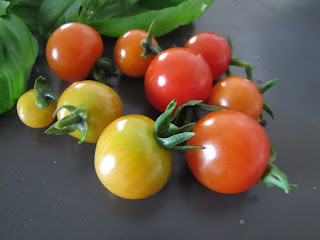Ciabatta
This recipe comes from my
River Cottage Bread Book. I have improved my knowledge and technique for making this bread after a long process of practice and research - looking at books and online websites and forums for tips and tricks. I have found the
Sourdough Companion, and the
Wild Yeast websites really useful. One common thing I read is that people take a few loaves, or a few dozen loaves, to get things right with making their own bread they are happy with and that isnt unpredictable anymore.
If you enjoy making bread you will go a long way fast. There are many ways to get advice too. I was impressed that on some of the online forums people post pictures of a cross-section of their loaves and get a diagnosis by the pros (artisan bakers and home bakers that subscribe to the forum) as to the quality of the bread. It is amazing that these people can look at the number and size of the air bubbles, the crust and crumb, the stodgyness of the lower bottom crust, and the shape of the loaves among other things which enables them to give precise advice about where and how the amateur baker might have gone astray. This can range from too long or short proving time to not enough water or too much or too little kneading, as well as the level of activity of the wild yeast starter used.
Below are two identical pieces of dough that were proved supported by linen cloth. The difference is that I rolled one over (and therefore upside down) onto the rimless baking tray (makeshift peel), and the other (at the front) was picked up with my hands and placed the same way up on the tray. As you can see it was deflated by my handling, and I was really gentle.
I had the same problem
last time I made this bread and I resorted to just proving on baking trays after that. However proving with support (on linen) really makes a nicer loaf I think. I have decided that the rolling action works well, as can be seen by the following picture. The corresponding two loaves are on the bottom left hand corner of the image, and you can see the stark comparison.

When I cut them, the deflated one was dense and not spongy, and the air bubbles were really small. The rest of the loaves were wonderful and had large holes and wonderful spongy airy texture (see below).
Ingredients
750g strong white flour
10g powdered dried yeast
25g fine salt
800ml warm water
1 tbsp extra virgin olive oil
Method
Mix all ingredients except the salt together and autolyse for 10 minutes.
Add the salt and stretch and fold it in to combine.
Bulk prove for 3 hours, stretching and folding at each 30 minute intervals. This gives structure to the gluten.
Stretching and folding will get easier as the gluten develops. Try wetting your hands with water before doing it (or olive oil) so they are slippery, not dry with flour. You dont want to add any more flour to this wet dough.
After the bulk prove, turn out onto a bench dusted with semolina and divide into six even portions.
Make the portions rectangles when cutting.
Lightly degas by pressing each piece all over then fold over from the long side to create a loaf that is 4 times long as it is wide. Place on floured linen cloth to prove until doubled in size.
Alternatively, place on a baking tray dusted with semolina (to avoid sticking) and cover with a plastic bag.
Preheat the oven to full.
Gently roll each loaf onto a peel or rimless tray/board from the linen so they are upside down (this evens out the bubbles). Slide onto baking stone and spray oven with water.
The baking stone adds fierce heat form below instantly to make the bubbles there rise and assure a good texture. It is not essential however, and if you have a thin baking tray the loaves should rise okay.
Bake for 10 minutes on full, then at 200degC for 15 minutes.
Cool completely (at least 30 minutes) before slicing, otherwise it will be doughey and sticky. You must let it continue to cook while it cools this way.
Serve with extra virgin olive oil (I use a lemon myrtle olive oil for dipping in dukkah).
These rolls also go well with a salad dinner in summer or a winter stew or a soup or even for lunch with air dried tomatoes and salami or for breakfast lik e the other day when we had an omlette to go on our long car trip....


















































